US Dollar Exchange Rates of
25th
May
2025
China Yuan 7.19
Report from China
Decline in China’s sawnwood imports
According to China Customs, sawnwood imports in the
first quarter of 2025 totalled 5.84 million cubic metres
valued at US$1.504 billion, down 13% in volume and 10%
in value compared to the first quarter of 2024. The average
price for imported sawnwood was US$258 (CIF) per cubic
metre, up 4% over the same period of 2024.
Of total sawnwood imports, sawn softwood imports
dropped 18% to 3.55 million cubic metres and accounted
for 61% of the national total. The average price for
imported sawn softwood rose 3% to US$206 (CIF) per
cubic metre over the same period of 2024.
Sawn hardwood imports dropped 4% to 2.28 million cubic
metres, accounting for 39% of the national total. The
average price for imported sawn hardwood increased 1.3%
to US$337 (CIF) per cubic metre over the same period of
2024.
Of total sawn hardwood imports, tropical sawnwood
imports were 1.69 million cubic metres valued at US$459
million CIF, down 8% in volume and 10% in value from
the same period of 2024 and accounted for 29% of total
sawnwood import volumes. The average price for
imported tropical sawnwood was US$272 CIF per cubic
metre, down 3% from the same period of 2024.


Decline in sawnwood imports from top suppliers
Russia was the largest supplier of China’s sawnwood
imports in the first quarter of 2025. The proportion of
China’s sawnwood imports from Russia accounted for
46% of the total sawnwood import volume.
Thailand was the second largest supplier of China’s
sawnwood imports in the first quarter of 2025. The
proportion of China’s sawnwood imports from Thailand
accounted for 19% of the total sawnwood imports volume.
China’s sawnwood imports from the two top countries,
Russia and Thailand, accounted for 65% of the national
total in the first quarter of 2025.
China’s sawnwood imports from Russia and Thailand fell
7% and 9% respectively in the first quarter of 2025. In
addition, China’s sawnwood imports from the top
suppliers, such as Canada, Belarus, Gabon and Sweden
reduced 39%, 18%, 15% and 30% respectively in the first
quarter of 2025.
All of the above-mentioned declines directly resulted in
the large decline of the total sawnwood imports over the
same period of 2024. Although China's sawnwood imports
from the United States and the Philippines have increased
(4% and 2% respectively) this failed to reverse the
downward trend of China's sawnwood imports in the first
quarter of 2025.
The reasons for the significant decline in China's
sawnwood imports are numerous such as the tariff friction
between China and the United States, the introduction of
stricter production standards by the European Union, the
impact of the adjustment of the origin policy in Southeast
Asia along the supply chain.
Also sharp fluctuations in international transportation
costs have led to an increase in sawnwood prices
internationally and raised the costs of China's sawnwood
imports.
Due to the weakness of China's real estate market the
willingness for development and investment is sluggish
and as a result the domestic demand for sawnwood is
weak. In the first quarter of 2025 the newly started
construction area of houses in China decreased by 24%
year-on-year.
The investment and demand in major sawnwood
consumption sectors such as construction and furniture
manufacturing decreased, resulting in a significant
reduction in China's sawnwood imports.
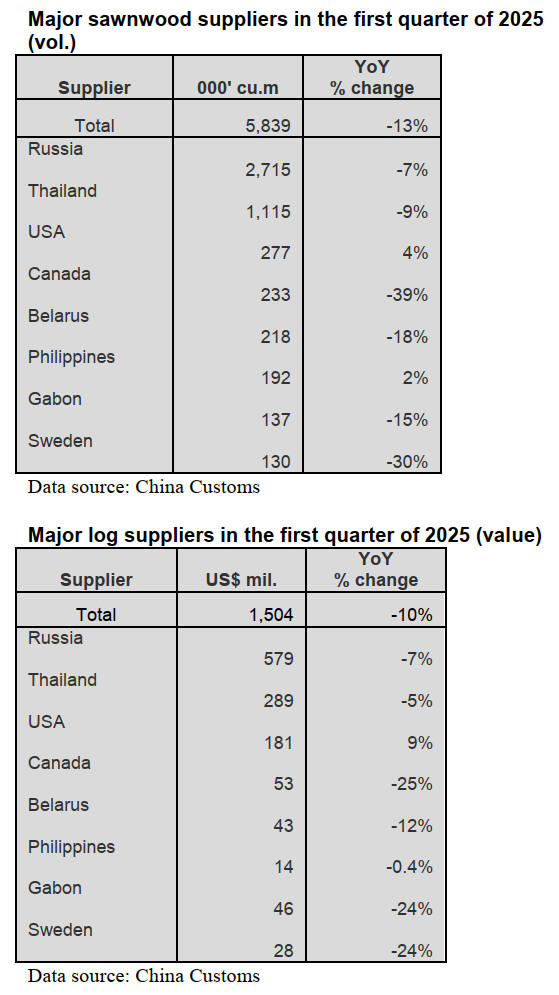
Main sawn softwood sources, first quarter of 2025
China’s sawn softwood imports from all of the top
suppliers fell at fast rates in the first quarter of 2025 which
resulted in the larger decline of the total sawn softwood
imports over the same period of 2024. China’s sawn
softwood imports fell 18% largely in the first quarter of
2025.
Russia is still the largest supplier for China’s sawn
softwood imports. 70% of China’s sawn softwood is from
Russia but sawn softwood imports from Russia fell 8% to
2.505 million cubic metres in the first quarter of 2025.
China’s sawn softwood imports from Canada, Belarus,
Sweden, Finland, Brazil, Chile and Germany decreased
41%, 18%, 30%, 59%, 10%, 26% and 72%% respectively
in the first quarter of 2025.
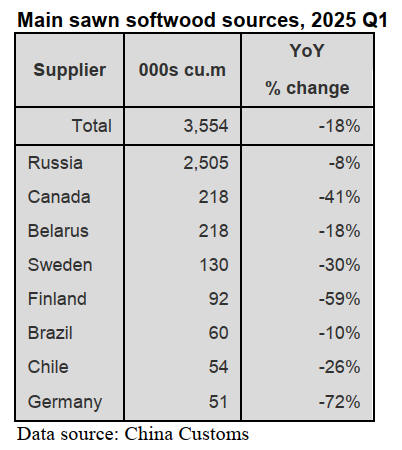
Surge in sawn hardwood imports from PNG
Thailand is the largest supplier of China’s sawn hardwood
imports. Nearly 50% of China’s sawn hardwood imports
are from Thailand but China’s sawn hardwood imports
from Thailand dropped 9%, which directly resulted in the
decline of the total sawn hardwood imports in the first
quarter of 2025. In addition, China’s sawn hardwood
imports from Gabon and Myanmar dropped 15% and 29%
respectively in the first quarter of 2025.
In contrast, China’s sawn hardwood imports from the
USA, Russia, the Philippines and Vietnam grew 3%, 5%,
2% and 23% respectively in the first quarter of 2025. It is
worth noting that the volume of sawn hardwood imports
from Papua New Guinea surged nearly 400% in the first
quarter of 2025.
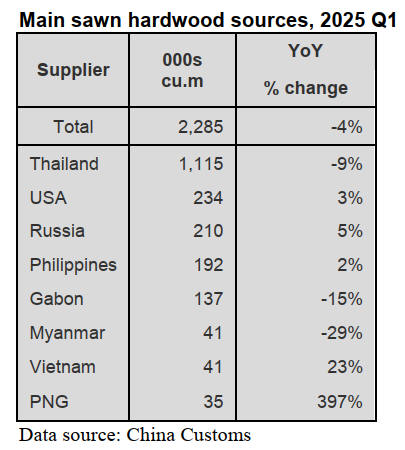
Decline in tropical sawnwood imports
China’s tropical sawnwood imports fell 8% to 1.689
million cubic meters in the first quarter of 2025. The top
three suppliers for China’s tropical sawnwood imports
were Thailand (66%), the Philippines (11%) and Gabon
(8%). 86% of China’s tropical sawnwood imports were
from these three countries in the first quarter of 2025.
China’s tropical sawnwood imports from Thailand, the
largest supplier, fell 9% in the first quarter of 2025, which
directly resulted in the decrease of the national total
tropical sawnwood imports in the first quarter of 2025. In
addition, China’s tropical sawnwood imports from Gabon,
Myanmar, Malaysia, Cameroon and Indonesia dropped
15%, 29%, 17%, 40% and 55% respectively in the first
quarter of 2025.
In contrast, China’s tropical sawnwood imports from the
Philippines, Vietnam and the Republic of Congo grew 2%,
8% and 25% respectively in the first quarter of 2025.
The volume of China’s tropical sawnwood imports has not
increased despite the reduction in prices in the first quarter
of 2025.
The export volume from Thailand, as a traditional tropical
sawnwood supplier, declined while emerging suppliers
such as the Philippines, Vietnam and PNG have shown
growth. This reflects that China's sources of tropical
sawnwood are gradually diversifying.
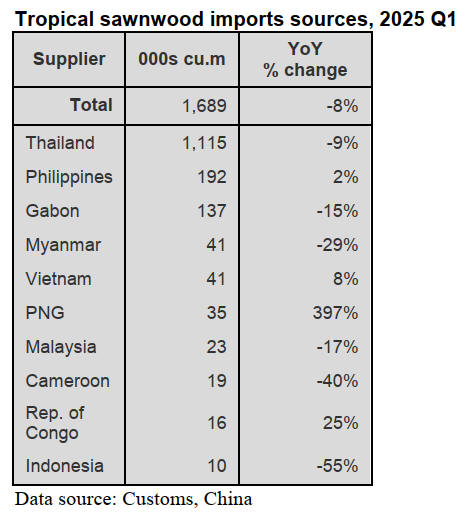
Decline in average CIF price for tropical sawnwood
imports
The average CIF price for China’s tropical sawnwood
imports in the first quarter of 2025 declined by 3% to
US$272 per cubic metres over the same period of 2024.
The CIF price for China's tropical sawnwood imports from
Thailand in the first quarter of 2025 rose 4% which is one
of the main reasons for the decrease in the volume of
tropical sawnwood imports from Thailand over the same
period of 2024.
The CIF price for China’s tropical sawnwood imports
from the Philippines fell 3% which is one of the main
reasons for the increase of China’s tropical sawnwood
imports from the Philippines in the first quarter of 2025.
The CIF price for China’s tropical sawnwood imports
from Gabon, Cameroon, the Republic of Congo and
Indonesia dropped 10%, 11%, 20% and 23% respectively
in the first quarter of 2025. In contrast, the CIF price for
China’s tropical sawnwood imports from Vietnam and
Malaysia rose 7% and 3% respectively in the first quarter
of 2025.
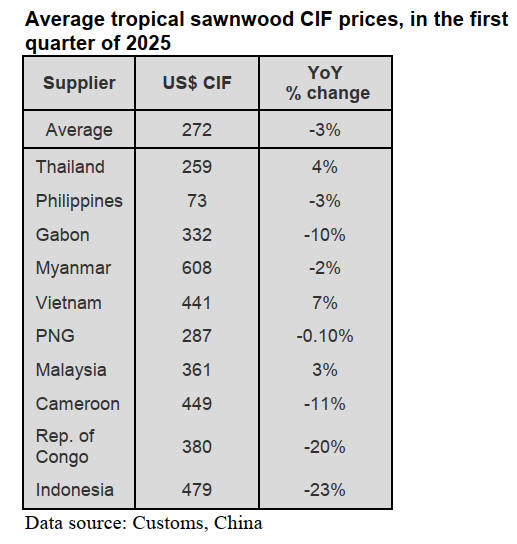
Frequent changes in US tariffs increase uncertainty
According to a press conference held by the China Council
for the Promotion of International Trade (CCPIT) a recent
survey conducted by the CCPIT among over 1,100 foreign
trade enterprises nationwide revealed that the frequent
changes in US tariff policies had significantly increased
uncertainty, making it difficult for businesses to make
long-term plans.
As a result, nearly 50% of the enterprises indicated that
they would reduce their business with the US.
Meanwhile, 75% of the enterprises planned to expand into
emerging markets to compensate for the decreased exports
to the US.
China's wood production rises in first quarter
At a press conference held by China’s Ministry of Natural
Resources it was reported that in the first quarter of 2025
China's wood production reached 25.1741 million cubic
metres marking an increase of 8% year-on-year.
According to customs data, from January to March 2025
China’s cumulative import volume of logs and sawnwood
was 13.906 million cubic metres, down by 11% compared
to the same period last year and the import value was
approximately 20.5 billion yuan, a decrease of 9% year-
on-year.
During the same period, China’s export value of furniture
and parts earned 114.46 billion yuan marking a decline of
7% compared to the same period in 2024.
April GTI-China index
In April 2025 the GTI-China index registered 54%, a
decrease of 4.0 percentage points from the previous month
and has been above the critical value (50%) for 2
consecutive months indicating that the business prosperity
of timber enterprises represented by the GTI-China index
expanded from the previous month.
In April China's timber market was at the traditional peak
season and the timber sector was generally on an upward
trend with production volume and both domestic and
international orders continued to rise.
As for the twelve sub-indices, ten indices (production,
new orders, export orders, existing orders, inventory of
finished products, purchase quantity, purchase price,
employees, delivery time and market expectations) were
all above the critical value of 50%, while the remaining
two indices (imports and inventory of main raw materials)
were below the critical value.
Compared to the previous month the indices for export
orders, inventory of finished products and delivery time
increased and the indices for production, new orders,
existing orders, purchase quantity, purchase price, imports,
inventory of main raw materials, employees and market
expectation declined.
See: https://www.itto-
ggsc.org/static/upload/file/20250519/1747635226558660.pdf
 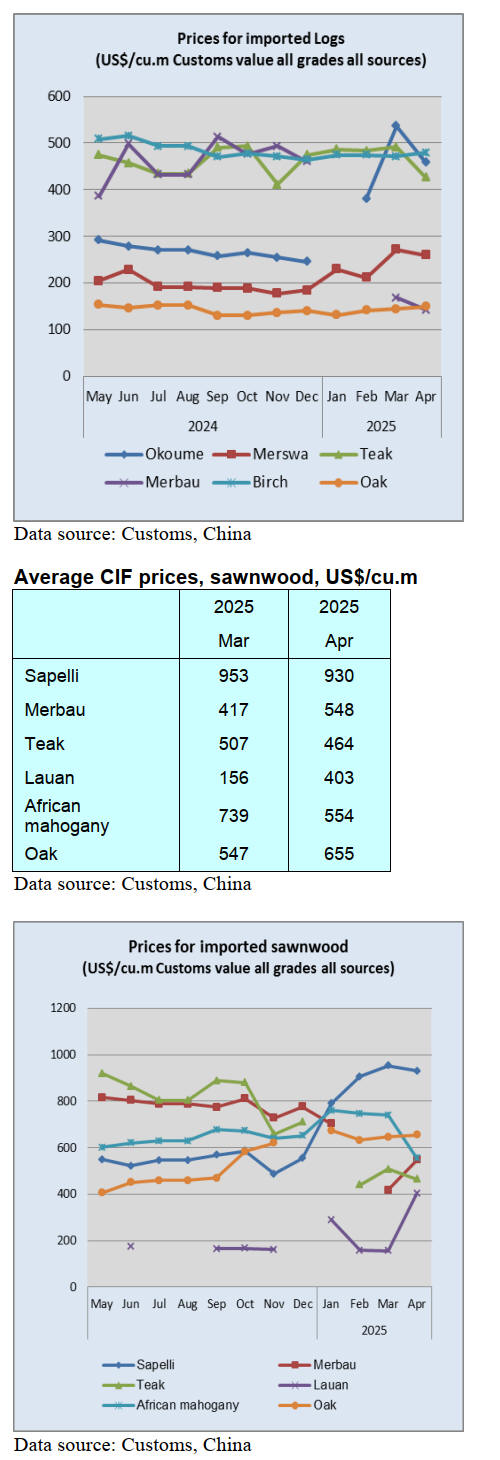
|